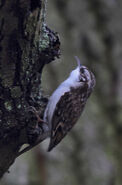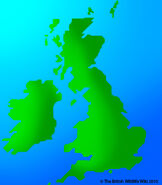The Treecreeper (Certhia familiaris), is a small passerine bird also known in the British Isles, where it is the only living member of its genus, simply as Treecreeper. It is similar to other treecreepers, and has a curved bill, patterned brown upperparts, whitish underparts, and long stiff tail feathers which help it creep up tree trunks.

Treecreeper - http://www.flickr.com/photos/gordiesbirdies
The Eurasian Treecreeper is insectivorous and climbs up tree trunks like a mouse, to search for insects which it picks from crevices in the bark with its fine curved bill. It then flies to the base of another tree with a distinctive erratic flight. This bird is solitary in winter, but may form communal roosts in cold weather.
Description[]
Similar in appearance, all treecreepers are small birds with streaked and spotted brown upperparts, rufous rumps and whitish underparts. They have long decurved bills, and long rigid tail feathers that provide support as they creep up tree trunks looking for insects.
The Eurasian Treecreeper is 12.5 cm (5 in) long and weighs 7.0–12.9 g (0.25–0.46 oz). It has warm brown upperparts intricately patterned with black, buff and white, and a plain brown tail. Its belly, flanks and vent area are tinged with buff. The sexes are similar, but the juvenile has duller upperparts than the adult, and its underparts are dull white with dark fine spotting on the flanks.
The contact call is a very quiet, thin and high-pitched sit, but the most distinctive call is a penetrating tsree, sometimes repeated as a series of notes. The male's song begins with srrih, srrih followed in turn by a few twittering notes, a longer descending ripple, and a whistle that falls and then rises.
Distribution and habitat[]
The Eurasian Treecreeper is the most widespread member of its genus, breeding in temperate woodlands across Eurasia from Ireland to Japan. It prefers mature trees, and in most of Europe, where it shares its range with Short-toed Treecreeper, it tends to be found mainly in coniferous forest, especially spruce and fir. However, where it is the only treecreeper, as in European Russia, or the British Isles, it frequents broadleaved or mixed woodland in preference to conifers.
Behaviour[]
Breeding[]
In Europe, the typical clutch of five–six eggs is laid between March and June. The eggs are white with very fine pinkish speckles mainly at the broad end, measure 16 x 12 mm (0.5 x 0.6 in) and weigh 1.2 g (0.04 oz) of which 6% is shell. The eggs are incubated by the female alone for 13–17 days until the altricial downy chicks hatch; they are then fed by both parents, but brooded by the female alone, for a further 15–17 days to fledging. Juveniles return to the nest for a few nights after fledging. About 20% of pairs, mainly in the south and west, raise a second brood.
Predators of treecreeper nests and young include the Great Spotted Woodpecker and Red Squirrels, and predation is about three times higher in fragmented landscapes than in solid blocks of woodland (32.4% against 12.0% in less fragmented woodlands). The predation rate increases with the amount of forest edge close to a nest site, and also the presence of nearby agricultural land, in both cases probably because of a higher degree of mustelid predation. The juvenile survival rate of this species is unknown, but 47.7% of adults survive each year. The typical lifespan is two years, but the maximum recorded age is eight years and ten months.
Feeding[]
The Eurasian Treecreeper typically seeks invertebrate food on tree trunks, starting near the tree base and working its way up using its stiff tail feathers for support. Unlike a nuthatch, it does not come down trees head first, but flies to the base of another nearby tree. It uses its long thin bill to extract insects and spiders from crevices in the bark. Although normally found on trees, it will occasionally hunt prey items on walls, bare ground, or amongst fallen pine needles, and may add some conifer seeds to its diet in the colder months.
Habits[]
As a small woodland bird with cryptic plumage and a quiet call, the Eurasian Treecreeper is easily overlooked as it hops mouse-like up a vertical trunk, progressing in short hops, using its stiff tail and widely splayed feet as support. Nevertheless, it is not wary, and is largely indifferent to the presence of humans. It has a distinctive erratic and undulating flight, alternating fluttering butterfly-like wing beats with side-slips and tumbles. Migrating birds may fly by day or night, but the extent of movements is usually masked by resident populations. It is solitary in winter, but in cold weather up to a dozen or more birds will roost together in a suitable sheltered crevice.
Gallery[]
Videos[]

The Treecreeper
Nature the Treecreeper! Persistance by Richard Claxton - http://www.youtube.com/user/richardclaxtoncni



